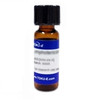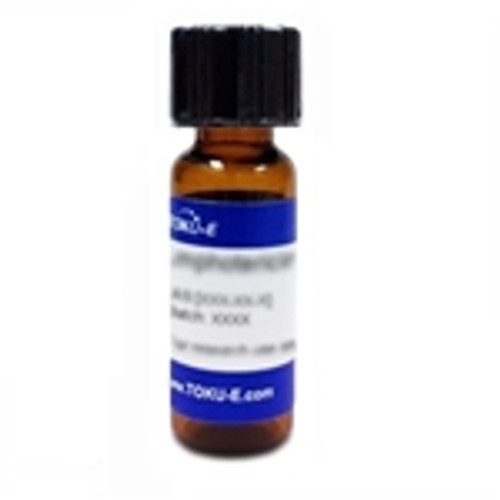Oligomycin A is a dominant analog of the Oligomycin class of macrocyclic lactones isolated from selected strains of Streptomyces sp. The class includes the analogs/isomers A through G. Different isomers are highly specific for the disruption of mitochondrial metabolism. Oligomycin A exhibits a broad biological profile including antifungal, antitumor and nematocidal activities.
Oligomycin A is an inhibitor of mitochondrial F1F0 ATP synthase. The Oligomycin complex was first reported in 1954, from a strain of Streptomyces diastatochromogenes from soil which was highly active against fungi. Oligomycins exhibit apoptotic cytotoxicity and mitochondrial toxicity.
Oligomycin A is soluble in ethanol, methanol, DMSO and DMF. It has poor water solubility.
We also offer:
- Oligomycin B (O018)
- Oligomycin C (O019)
- Oligomycin D (O020)
- Oligomycin E (O021)
- 21-Hydroxyoligomycin A (H032)
| Application | Oligomycin can be used to demonstrate ‘proton leak’, the depletion of Δp in the presence of the ATP synthase inhibitor. Useful tool in cytochemistry. Used to study effects of ATP depletion. |
| Spectrum |
Oligomycin A is active against fungi including Aspergillus and Penicillium. |
| Mechanism of Action | Oligomycin inhibits phosphoryl group transfer in mitochondrial membrane-bound ATP synthase (F1F0 ATPase), blocking proton translocation and leading to hyperpolarization of inner mitochondrial membrane. The result is that mitochondrial ATP is not synthesized.
After more than 50 years of studies on the binding site of Oligomycin, a team at the Rosalind Franklin University (North Chicago, IL) discovered that it binds to the subunit-c of the F0 portion of the ATP synthase. The residues involved in the binding site are conserved from yeast to humans (Symersky et al, 2012). |
| Microbiology Applications | A number of mutations in yeast have been shown to confer resistance to Oligomycin. |
| Eukaryotic Cell Culture Applications | Oligomycin is used to study ATP-linked respiration and is used for the maximal capacity respiration assay in astrocytes, at 1 µM for MEFs and 2 µM for astrocytes. It can be used to measure oxygen consumption in commercial kits such as the Mito Stress Test kit (Agilent). The compound is serially injected to measure ATP-linked respiration. The test can help quantify parameters of mitochondrial respiration and identify mitochondrial dysfunction (Atzmon et al, 201). Oligomycin can be used to measure oxygen consumption rate and extracellular acidification rates in breast cancer cell lines, contributing to our understanding of molecular pathways that contribute to breast cancer progression (Furth et al, 2018). |
| Cancer Applications | Mitochondria are regulators in apotosis, thus are a target for cancer research. Oligomycin was found to bypass doxorubicin resistance and block P-glycoprotein activity. P-glycoprotein causes multidrug resistance, and extrudes anticancer drugs to the extracellular environment using ATP. The result was that it triggered apoptosis in drug-resistant HepG2 cells (Li et al, 2002).
Oligomycin has been used to study the mechanistic aspects of ATP formation in tumor cell biology and apoptosis. |
| Solubility | Oligomycin A is soluble in ethanol, methanol, DMSO and DMF. It has poor water solubility. |
| References |
Atzmon A et al (2018) Drug screening identifies sigma-1-receptor as a target for the therapy of VWM leukodystrophy. Front. Mol. Neurosci 11. 336 pp. doi 10.3389 Furth N et al (2018) LATS1 and LATS2 suppress breast cancer progression by maintaining cell identity and metabolic state. Life Sci. Alliance. 1(5):e201800171 PMID 30456386 Jastroch M (2010) Mitochondrial proton and electron leaks. Essays Biochem. 47:53-67 doi:10.1042/bse0470053 Li YC et al (2002) Mitochondria-targeting drug Oligomycin blocked P-glycoprotein activity and triggered apoptosis in doxorubicin-resistant HepG2 cells. Pharmacol. 50:55-62 Miyoshi N, Oubrahim H, Chock PB And Stadtman ER (2006) Age-dependent cell death and the role of ATP in hydrogen peroxide-induced apoptosis and necrosis. Proc. Natl. Acad. Sci. USA 103(6):1727-1731 PMID 16443681 Peachman KK, Lyles DS and Bass DA (2001) Mitochondria in eosinophils: Functional role in apoptosis but not respiration. Proc. Natl Acad. Sci. USA 98(4):1717-1722 PMID 11172017 Raini G et al (2017) Mutant elf2B leads to impaired mitochondrial oxidative phosphorylation in vanishing white matter disease. J. Neurochem. 141(5):694-707 Smith RM, Peterson WH and McCoy E (1954) Oligomycin, a new antifungal antibiotic. Antibiotics and Chemother. 4(9):962-970 Symersky J et al (2012) Oligomycin frames a common drug-binding site in the ATP synthase. Proc. Natl. Acad. Sci. USA 109(35):13961-13965 |








